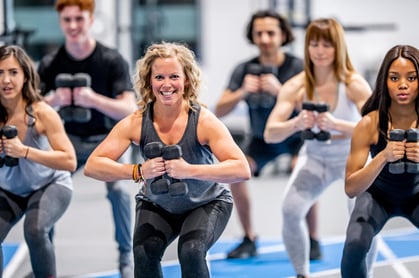 How do you define fitness? Whatever your answer is, it will shape the way you work out, influence the goals you set, and impact your long-term health. Although everyone might have different perceptions of what “fitness” means, the American College of Sports Medicine has defined what Health-Related Physical Fitness is and has broken it down into five measurable components.
How do you define fitness? Whatever your answer is, it will shape the way you work out, influence the goals you set, and impact your long-term health. Although everyone might have different perceptions of what “fitness” means, the American College of Sports Medicine has defined what Health-Related Physical Fitness is and has broken it down into five measurable components.
Whether you know it or not, you use every single component in everyday life, so incorporating all of these factors is vital to maintaining high quality of life. As people age, their ability to carry out certain tasks may become compromised if they don’t regularly challenge their bodies to perform them. So, one key to aging well is to incorporate all of the components of health-related physical fitness.
The 5 Components of Health-Related Physical Fitness
- Body composition is the comparison between fat mass and fat-free mass, where fat-free mass is everything that isn’t fat, including muscle, organs, bones, and so on. This proportion can be used to assess risk for potential health issues, or used as a baseline measure to be retested after you have started a program to track progress. There are several ways to measure body composition; the most accurate methods are water displacement or the BodPod. (See the complete list of NIFS assessments here.)
- Muscular strength is the amount of force a muscle can produce in a single maximal effort. Muscular strength is relative to a specific muscle group, so a few different tests may need to be conducted to get an overall picture of your strength. A grip strength test is popular and has been utilized frequently in the fitness world. Another is the Repetition Maximum test that can be conducted by the NIFS Health and Fitness Instructors. It is important to gain or maintain muscular strength as you age for many reasons, but we use our strength every day.
- Muscular endurance, by definition, is the ability of a muscle group to execute repeated contractions over a period of time sufficient to cause fatigue. Like muscular strength, it varies depending on the muscle group, so multiple tests are required for a proper assessment. A common muscular endurance test is the pushup test (you’re probably familiar with this test from grade school). Another is the plank test, which is relatively new, and is a way to get a baseline value for core endurance and use it as a reference for retesting to measure improvements.
- Flexibility is having the ability to move a joint through its full range of motion. Having sufficient flexibility can help prevent injuries and ensure that you’re capable of performing movements that you may need in daily life. While having enough flexibility is necessary, too much can be risky.
- Cardiovascular endurance is the ability of the cardiovascular and respiratory systems to deliver oxygen to the rest of the body during continuous exercise. It’s directly correlated to our ability to perform exercise that involves large muscles, dynamic movements, and moderate- to high-intensity workouts over a period of time. Having adequate cardiovascular endurance is vital to keep up with daily activities.
Start with Things You Like to Do and Then Branch Out
If your main goal is to achieve good health, you’ll want to make sure you distribute your training so you can hit all of the categories. Start by doing things you like to do and then branch out by trying new things. It’s common for people to tailor their training to one particular component for whatever goal they are trying to achieve, but to be lacking in most of the other areas. For example, a marathon runner might excel in cardiovascular endurance but be less than average in muscular strength or flexibility.
On the other hand, someone who only lifts heavy weights may lack cardiovascular endurance. However, the runner may start to notice running is easier after incorporating resistance training into their routine, or their muscles might feel great after adding stretching and mobility work. This doesn’t just apply to marathon runners or heavy lifters; almost everyone can benefit from including all 5 components into their routines.
To sum it up, you should practice different forms of exercise to achieve a holistic fitness regimen. It’s perfectly fine to include running, resistance training, or group fitness such as yoga or STEP, and that’s just a few examples. There are so many different activities and classes to try to help get you to your goals. When you blend different types of training, you can discover your talents, weak links, and things you just enjoy doing.
This blog was written by Hannah Peters, BS, CPT, Health Fitness Instructor. To learn more about the NIFS bloggers, click here.

